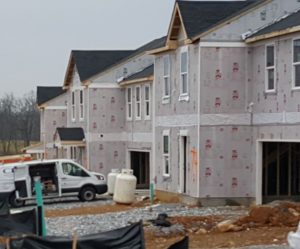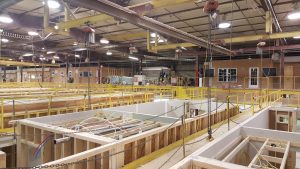How do you know that the new home you are living in meets current building code? Does your state observe a written building code? Does your state, county, or city require a building permit to build a new home? What does getting a building permit really mean? Are there any inspections done on homes that are built to ensure they meet the building code required in your area? These are all good questions… and the answer to each of them may scare you. In about half of the counties in the U.S. there are no building inspections. Yes, you read that correctly. So how do you know your home was built to the current building code if it wasn’t inspected? The actual answer is… you don’t. Not unless it was built using off-site modular construction!
WHAT IS A BUILDING CODE?
Building codes are sets of regulations governing the design, construction, alteration, and maintenance of structures. They specify the minimum requirements to adequately safeguard the health, safety, and welfare of building occupants.
 In the U.S., most states don’t make and manage their own codes. Instead, they adopt a model building code that is created by an organization called the International Code Council (ICC). The ICC creates model codes for both residential and commercial construction. These include:
In the U.S., most states don’t make and manage their own codes. Instead, they adopt a model building code that is created by an organization called the International Code Council (ICC). The ICC creates model codes for both residential and commercial construction. These include:
- International Building Code (IBC): Applies to almost all types of new buildings
- International Residential Code (IRC): Applies to new one- and two-family dwellings and townhouses of not more than three stories in height
- International Existing Building Code (IEBC): Applies to the alteration, repair, addition, or change in occupancy of existing structures.
The ICC is on a three-year cycle. It publishes new editions of the International Codes every three years and many states and localities have adopted them since the first editions were issued in 2000. Prior to that, there were three regionally-based model code organizations; the BOCA National Code, the SBCCI Standard Code and the ICBO Uniform Code that combined together to form the ICC.
At the state level, every state adopts a version of the model code to follow. For example, the 2012 IRC. It may be 2020 but the state is using the 2012 version of the IRC until it votes to adopt a more current version, such as the 2018 edition. Here is where it starts to get interesting. What if the state adopts a building code but your rural county doesn’t have a building code enforcement office or even a building permit office? Read on.
WHAT DOES GETTING A BUILDING PERMIT REALLY MEAN?
Many localities have the requirement to obtain a building permit before you start construction. In some areas, this jurisdiction could be a county or a city. And, the requirement to actually get one may only be for certain types of construction. You may need to obtain a permit for new construction but not for the remodeling of an existing structure. In many areas of the country, the requirement to get a building permit only exists to ensure that the local tax assessor knows that you a changing or constructing a building that may change a property’s value. It is their trigger to reassess the value of the property when you’re done so they may be able to increase the property tax assessment.
RELATED: The Devil in the Details
About half of the U.S. is so rural that there is no government body to issue a building permit. There is no state, county, or city body that requires you to even make them aware that you are building a home in their jurisdiction. For example, in West Virginia, there are 55 counties. Only 14 of those counties even have the ability to require and therefore issue a building permit. So, if they aren’t aware that a home is even being constructed, how do they inspect it to know it is being built to the required building code? The answer is: THEY AREN’T.
HOME INSPECTIONS
Home inspectors for an existing home are typically third party inspectors that have been trained and are certified by taking a national test. They are engaged by a home buyer when they are buying an existing home to review it. They are searching for things like termite damage, mold issues, and electrical issues, just to name a few. In short, they are looking for life and safety issues with a home you are about to purchase or for major items that are at their end of lifecycle and may need costly repair or replacement soon. They aren’t looking for quality issues in the home itself.
Home inspectors for a new home are trained and are inspecting new construction work that has been done to be in compliance with the current building code in place for the jurisdiction where they work. They are inspecting structural items, electrical items, mechanical items, etc. They aren’t doing a 100% inspection of everything in the new home. They can’t, it would take too much time. But they find the big things. They also aren’t quality inspectors. They are checking for code compliance, not quality assurance. Just remember, about half of the counties in the U.S. have no requirement to have a home that is built onsite inspected.
BUILDER LICENSING
 AT THIS POINT, YOU MUST BE SAYING TO YOURSELF, “WELL, IF THERE IS NO BUILDING PERMIT REQUIRED FOR A HOME AND THERE IS NO INSPECTION REQUIREMENT BY MY STATE OR COUNTY FOR MY HOME, THEN MY BUILDER MUST HAVE TAKEN A TEST AND BE LICENSED TO ENSURE HE KNOWS HOW TO BUILD TO THE CURRENT BUILDING CODE.” AGAIN, YOU WOULD BE WRONG.
AT THIS POINT, YOU MUST BE SAYING TO YOURSELF, “WELL, IF THERE IS NO BUILDING PERMIT REQUIRED FOR A HOME AND THERE IS NO INSPECTION REQUIREMENT BY MY STATE OR COUNTY FOR MY HOME, THEN MY BUILDER MUST HAVE TAKEN A TEST AND BE LICENSED TO ENSURE HE KNOWS HOW TO BUILD TO THE CURRENT BUILDING CODE.” AGAIN, YOU WOULD BE WRONG.
In about two-thirds of the states, there is no testing for a builder to be a builder. He simply declares himself or herself to be a builder and it is so. There may be a requirement to pay a fee, register with a state board, or take an 8 hour class, but that is it. So what about continuing education? Only a handful of states that require licensing have any sort of requirement for a builder to stay up to date with new techniques or code requirements through continuing education.
“WE BUILD OUR HOMES TO CURRENT BUILDING CODE”

If you talk with a builder and he says he stick builds all of his homes onsite and that all of his homes are built to meet the required local or state building code, what he is really saying is that he is providing you with the worst home allowed by law. Don’t accept that just because your new home meets the minimum building code that it is well built.
For example, in many locations where building permits are required and building inspections take place you can actually build a home with cardboard walls on the exterior under your siding! Yes, it’s true. Most production builders use this cardboard sheet product that has fibers and is chemically treated to meet building code to withstand shear (lateral forces)… and it’s cheaper than OSB. However, it is a sheet of cardboard. A thief could take a box cutter knife and cut your siding, cut the cardboard exterior, cut the insulation and drywall and be in your living room while barely making a sound and without going through a window or door. The only OSB or plywood in your home is on your floors. There is absolutely none in your home’s walls!
But, there is a better way. A better building method that ensures your home is inspected, for both quality and code compliance, and that it is better constructed using better materials.
OFF-SITE MODULAR CONSTRUCTION MEANS YOUR HOME WAS INSPECTED…
 WHEN YOU USE OFF-SITE MODULAR CONSTRUCTION, IT MEANS THAT SO MANY OF THE ISSUES WITH ONSITE CONSTRUCTION ARE SOLVED. THE PROCESS PUT IN PLACE BY EACH STATE MEANS THAT YOUR HOME IS REQUIRED TO BE BUILT TO CURRENT BUILDING CODE AND INSPECTED TO MEET THE BUILDING CODE FOR HOMES BUILT USING OFF-SITE MODULAR CONSTRUCTION. THIS IS DONE THROUGH A 3RD PARTY SYSTEM.
WHEN YOU USE OFF-SITE MODULAR CONSTRUCTION, IT MEANS THAT SO MANY OF THE ISSUES WITH ONSITE CONSTRUCTION ARE SOLVED. THE PROCESS PUT IN PLACE BY EACH STATE MEANS THAT YOUR HOME IS REQUIRED TO BE BUILT TO CURRENT BUILDING CODE AND INSPECTED TO MEET THE BUILDING CODE FOR HOMES BUILT USING OFF-SITE MODULAR CONSTRUCTION. THIS IS DONE THROUGH A 3RD PARTY SYSTEM.
Most states can’t issue building permits and perform inspections at the state level. However, they can delegate that authority to engineering firms to act on their behalf, and that is what most of them do. It should make you feel safer knowing that in most states, your home plan was reviewed by an engineer. It assures that your home is designed to meet the current building code. But once they provide their stamp, it doesn’t stop there. In fact, it is just starting!
The state also delegates inspection authority so that a third party is required to inspect each home ensuring it is in compliance with state building code and that it is built to the plan that was stamped as meeting state code requirements. Because home construction is concentrated in a factory, this can be easily done. And it doesn’t stop there. Not only are third-party inspectors checking for code compliance, but factory inspectors are checking for quality compliance. A factory wants to produce the best home it can. If there are issues, they have to fix them. It is much cheaper for that factory to fix quality issues at the factory than hundreds of miles away at a home site!
MODULAR MEANS IT’S ONLY GOOD ENOUGH IF ITS RIGHT!
In the U.S. we are suffering from a housing shortage. We just can’t build homes fast enough to meet the home buyer demand. When that happens things can get sloppy. Good enough becomes good enough. And as you now know, the system perpetuates the “good enough” philosophy when it comes to building your new home UNLESS… you are using off-site modular construction. Off-site modular construction is a system. It is a building system that assures you that no matter where you live that your home was built right, it was built well, and that it met and most likely exceeded the building code it was built to comply with.
Off-site modular construction is exactly what its name describes. A home plan is divided up into modules, construction offsite, and then placed on carriers for delivery to the home site where it will be placed on its foundation with a crane. Modular design is flexible and modular construction complies to the same building code that a home built onsite is supposed to comply with. In addition, they are built to withstand the travel to a home site and the lift by crane cables so that the easiest thing your home will ever do is rest on its foundation. However, it was built for the hard part. How your home is built matters! You can rest easier when you know that you and your family are living in a home built using modular construction!



Comments(0)